| Implants
Now there is an alternative for replacing a missing tooth, missing
teeth or help anchor dentures securely. Implantology has been in
dentistry for decades but only in the past 10 years or so has it
become much more predictable and successful. There are now thousands
of implants placed each year world wide with tremendous long-term
success.
Implant Longevity
Just like your real teeth, implants require very careful cleaning
each and every day. Regular dental hygiene appointments are just
as important (if not more so). It is true that implants can't decay,
but they are susceptible to periodontal problems just like real
teeth. Smoking is a factor with implant failure and should be discont
inued for long term success. Other very important factors are the
correct placement of your implant in secure bone and a very correct
bite to minimize stresses - these decisions are made by the doctor
directing your care.
There are implants that have been successfully used for over 30
years. Now, with a better understanding of fundamentals and studies
performed, we expect implants to be 95%+ successful for 30 years
and most likely a lifetime.
Placement technique
The implant itself is made from titanium. Titanium has a very high
affinity to bone. After a careful medical and dental history is
taken and evaluated. Proper models, x-rays and other diagnostic
tools are reviewed and the decision to use an implant has been made
- the actual placement occurs. At the time of the implant placement
(an office procedure, usually under an i.v. sedation) an incision
is made and a "core" of bone is easily and carefully removed
that corresponds exactly to the length and diameter of the implant
body. The implant is seated, the tissue repositioned and sutured
into place. Most people who undergo this surgery say that the discomfort
is minimal post operatively.
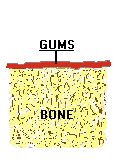
Bone before surgery |
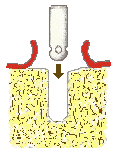
The implant ready for placement |
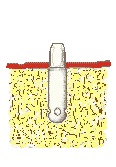
The implant extending through the gums |
Now the implant actually "osseous integrates" (biologically
fuses) to the bone. This process takes usually from 4 to 6 months.
During this time, the implant remains covered over and no forces
are placed on it. Dentures may be worn during this healing time.
The implant top is exposed and an extension is placed so that the
gums can heal to form a tight seal at the gum margin .
Tooth Replacement
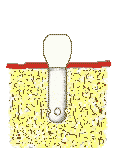 |
The crown (cap) is placed
over the implant extension through a series of very precise
impressions and lab procedures. Finally the finished crown is
cemented or screwed into place on the implant
|

Animation sequence to show the implant procedure |

An X-Ray of the crown joining an implant |
Denture Anchoring
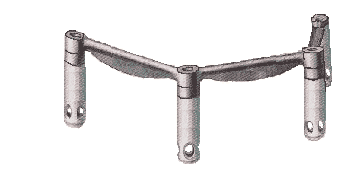
Bar supported by implants |
You don't need
14 implants to replace all of the lower teeth, just a few
implants correctly placed will support a denture. Most cases
require between 2 and 5 implants to provide excellent results.
Generally, if you want teeth that are not removed, it will
require that more implants be placed. Because they're more
easily cleansed, we prefer that the implant supported teeth
be removable. Another excellent reason for removable teeth
is that they act like a shock absorber for the implants.
Through a series of very precise impressions and lab procedures,
a bar is made to precisely fit over the top of each implant
extension. The bar has a shape that will accommodate plastic
snaps to fit over it. These snaps are then transferred to
the inside of the denture base. With the denture snapped into
position, all the implants, bar and snaps are hidden by the
denture acrylic.
Implants are a very exciting part of todays dentistry. If there
is an opportunity for us to share any information or provide
a consultation for possible implant placement, please do not
hesitate to call.
|
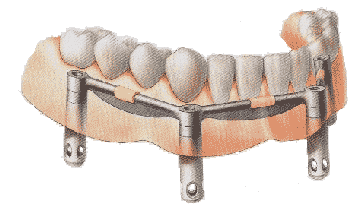
Denture over bar and implants (the bar and
snaps are hidden by denture) |
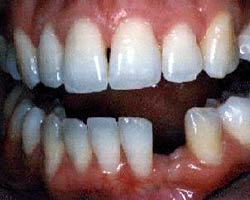 |
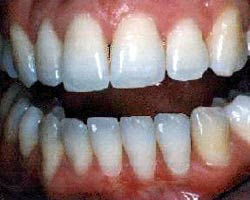 |
|


